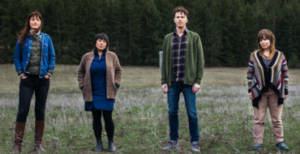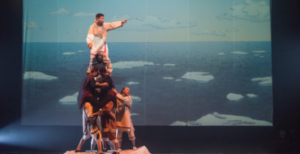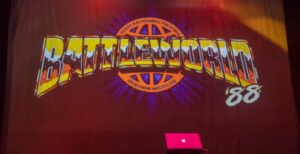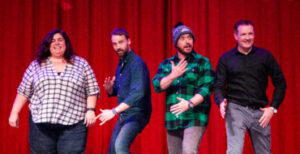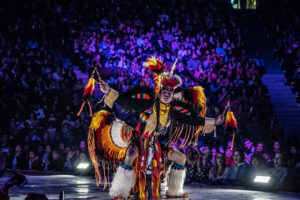
Full Indie is an organization that originally supported independent game developers in Vancouver through meetups where indies have the chance to bring their projects and show them off to others, get feedback, and form connections. Since 2010, these meetups have grown bigger and bigger, and today, they draw over 150 people monthly, with a massive waitlist still. The size and demand for Full Indie has prompted the organization to gradually expand into doing things like game jams, development workshops, and speaking events, but April 20 marked the first Full Indie Summit at the Rio Theatre.
Retro City Rampage developer and superhuman Brian Provinciano came up with the idea of bringing together a bunch of Vancouver’s most influential indie developers to talk about their games, other people’s games, and how to make them.
Arriving at the Rio at around 9:30 am on Saturday had me halfway down the block at the end of a snaking lineup that had no right to be there. This was essentially going to be six hours of people talking about how to make video games in a dark theatre, but as we got settled into the venue, the available seating quickly filled up and many spent the day sitting in the aisles, but nobody seemed to mind.
Not that there wasn’t enough talent to draw a crowd. Brian Provinciano is one of the biggest local names, having singlehandedly developed Retro City Rampage, which has been met with great success.

The first speaker was Nels Anderson, lead designer on
Mark of the Ninja, a 2012 Xbox Live Arcade title that garnered critical acclaim, and perfect scores. He gave a shortened version of a talk he did at the Game Developers Conference in San Francisco, on the design inspiration behind the game, the problems of solving perfect stealth, and the five design heresies committed by Mark of the Ninja. He spoke on how the game’s design went against convention in a lot of ways, like by moving away from open level design and by limiting the consequence of player failure, especially when the penalty is progress.

His academic breakdown of a single game was immediately followed by two Seattle developers known as Skull Theatre who were instead talking about how they use a specific graphics technique known as photogrammatery. The duo is working on a PC adventure game called
Rustclad that contains totally handcrafted 3D assets – quite a feat for a small indie team. They accomplished this through the technique known as photogrammatery, which involves photographing objects and textures, and using special software to easily create 3D models out of them.
The day saw more than just indies take the stage however. One of the speakers was Joel Green, an audio designer at BioWare Montreal who has worked on the Mass Effect and Dragon Age franchises. He recently moved to a fairly remote area of Vancouver Island, and gave a fascinating talk on how environment informs design. He argued that game developers have the ability to work from wherever they want – so why don’t they?
The day saw many other prominent local developers talking about their own specializations – frequent game jam participant Nick Yonge spoke about rapid development cycles, and
Skulls of the Shogun designer Jake Kazdal did a Q&A with Brian Provinciano on much longer development cycles, as both are known for games which took several years to develop.
One of the surprises during the day was two presentations from Sony and Nintendo about how indies can get their games on the companies’ platforms. Head of Publisher Relations at SCEA Adam Boyes gave a great talk that opened up a bit of the internal circuitry at Sony, and shed some much-needed light on the path to getting your game published on a Sony platform, something many assume to be a difficult process. Sony is clearly taking major steps this generation with the PlayStation Vita and PS4 to open up the platform for independent titles after the late-in-the-life success of games like Journey and The Unfinished Swan on the PS3.
Nintendo’s Dan Adelman works as a kind of liaison between developers and the E-Shop, Nintendo’s online distribution channel. His talk was similar in content to Boyes’, except for the fact that it instilled little excitement to work with them. Where Boyes highlighted the simplicity and speed of getting your games onto a Sony platform, the Nintendo process in comparison seems archaically slow and bureaucratic. In Adelman’s defence, he seemed to be saddled with a lot more red tape than Boyes, and was unable to talk about many things, which is a shame, because with the sour launch of the Wii U, indie support is something Nintendo should really be trying to foster.
Shortly before 4 pm, the first Full Indie Summit came to a close. Even as someone who is purely a fan, the only bad thing I can say about my six hours in the Rio is that maybe they could have turned a light on. Or let us stand up. Or had sandwiches under every seat.
 Full Indie is an organization that originally supported independent game developers in Vancouver through meetups where indies have the chance to bring their projects and show them off to others, get feedback, and form connections. Since 2010, these meetups have grown bigger and bigger, and today, they draw over 150 people monthly, with a massive waitlist still. The size and demand for Full Indie has prompted the organization to gradually expand into doing things like game jams, development workshops, and speaking events, but April 20 marked the first Full Indie Summit at the Rio Theatre.
Retro City Rampage developer and superhuman Brian Provinciano came up with the idea of bringing together a bunch of Vancouver’s most influential indie developers to talk about their games, other people’s games, and how to make them.
Arriving at the Rio at around 9:30 am on Saturday had me halfway down the block at the end of a snaking lineup that had no right to be there. This was essentially going to be six hours of people talking about how to make video games in a dark theatre, but as we got settled into the venue, the available seating quickly filled up and many spent the day sitting in the aisles, but nobody seemed to mind.
Not that there wasn’t enough talent to draw a crowd. Brian Provinciano is one of the biggest local names, having singlehandedly developed Retro City Rampage, which has been met with great success.
Full Indie is an organization that originally supported independent game developers in Vancouver through meetups where indies have the chance to bring their projects and show them off to others, get feedback, and form connections. Since 2010, these meetups have grown bigger and bigger, and today, they draw over 150 people monthly, with a massive waitlist still. The size and demand for Full Indie has prompted the organization to gradually expand into doing things like game jams, development workshops, and speaking events, but April 20 marked the first Full Indie Summit at the Rio Theatre.
Retro City Rampage developer and superhuman Brian Provinciano came up with the idea of bringing together a bunch of Vancouver’s most influential indie developers to talk about their games, other people’s games, and how to make them.
Arriving at the Rio at around 9:30 am on Saturday had me halfway down the block at the end of a snaking lineup that had no right to be there. This was essentially going to be six hours of people talking about how to make video games in a dark theatre, but as we got settled into the venue, the available seating quickly filled up and many spent the day sitting in the aisles, but nobody seemed to mind.
Not that there wasn’t enough talent to draw a crowd. Brian Provinciano is one of the biggest local names, having singlehandedly developed Retro City Rampage, which has been met with great success.
 The first speaker was Nels Anderson, lead designer on Mark of the Ninja, a 2012 Xbox Live Arcade title that garnered critical acclaim, and perfect scores. He gave a shortened version of a talk he did at the Game Developers Conference in San Francisco, on the design inspiration behind the game, the problems of solving perfect stealth, and the five design heresies committed by Mark of the Ninja. He spoke on how the game’s design went against convention in a lot of ways, like by moving away from open level design and by limiting the consequence of player failure, especially when the penalty is progress.
The first speaker was Nels Anderson, lead designer on Mark of the Ninja, a 2012 Xbox Live Arcade title that garnered critical acclaim, and perfect scores. He gave a shortened version of a talk he did at the Game Developers Conference in San Francisco, on the design inspiration behind the game, the problems of solving perfect stealth, and the five design heresies committed by Mark of the Ninja. He spoke on how the game’s design went against convention in a lot of ways, like by moving away from open level design and by limiting the consequence of player failure, especially when the penalty is progress.
 His academic breakdown of a single game was immediately followed by two Seattle developers known as Skull Theatre who were instead talking about how they use a specific graphics technique known as photogrammatery. The duo is working on a PC adventure game called Rustclad that contains totally handcrafted 3D assets – quite a feat for a small indie team. They accomplished this through the technique known as photogrammatery, which involves photographing objects and textures, and using special software to easily create 3D models out of them.
The day saw more than just indies take the stage however. One of the speakers was Joel Green, an audio designer at BioWare Montreal who has worked on the Mass Effect and Dragon Age franchises. He recently moved to a fairly remote area of Vancouver Island, and gave a fascinating talk on how environment informs design. He argued that game developers have the ability to work from wherever they want – so why don’t they?
The day saw many other prominent local developers talking about their own specializations – frequent game jam participant Nick Yonge spoke about rapid development cycles, and Skulls of the Shogun designer Jake Kazdal did a Q&A with Brian Provinciano on much longer development cycles, as both are known for games which took several years to develop.
One of the surprises during the day was two presentations from Sony and Nintendo about how indies can get their games on the companies’ platforms. Head of Publisher Relations at SCEA Adam Boyes gave a great talk that opened up a bit of the internal circuitry at Sony, and shed some much-needed light on the path to getting your game published on a Sony platform, something many assume to be a difficult process. Sony is clearly taking major steps this generation with the PlayStation Vita and PS4 to open up the platform for independent titles after the late-in-the-life success of games like Journey and The Unfinished Swan on the PS3.
Nintendo’s Dan Adelman works as a kind of liaison between developers and the E-Shop, Nintendo’s online distribution channel. His talk was similar in content to Boyes’, except for the fact that it instilled little excitement to work with them. Where Boyes highlighted the simplicity and speed of getting your games onto a Sony platform, the Nintendo process in comparison seems archaically slow and bureaucratic. In Adelman’s defence, he seemed to be saddled with a lot more red tape than Boyes, and was unable to talk about many things, which is a shame, because with the sour launch of the Wii U, indie support is something Nintendo should really be trying to foster.
Shortly before 4 pm, the first Full Indie Summit came to a close. Even as someone who is purely a fan, the only bad thing I can say about my six hours in the Rio is that maybe they could have turned a light on. Or let us stand up. Or had sandwiches under every seat.
His academic breakdown of a single game was immediately followed by two Seattle developers known as Skull Theatre who were instead talking about how they use a specific graphics technique known as photogrammatery. The duo is working on a PC adventure game called Rustclad that contains totally handcrafted 3D assets – quite a feat for a small indie team. They accomplished this through the technique known as photogrammatery, which involves photographing objects and textures, and using special software to easily create 3D models out of them.
The day saw more than just indies take the stage however. One of the speakers was Joel Green, an audio designer at BioWare Montreal who has worked on the Mass Effect and Dragon Age franchises. He recently moved to a fairly remote area of Vancouver Island, and gave a fascinating talk on how environment informs design. He argued that game developers have the ability to work from wherever they want – so why don’t they?
The day saw many other prominent local developers talking about their own specializations – frequent game jam participant Nick Yonge spoke about rapid development cycles, and Skulls of the Shogun designer Jake Kazdal did a Q&A with Brian Provinciano on much longer development cycles, as both are known for games which took several years to develop.
One of the surprises during the day was two presentations from Sony and Nintendo about how indies can get their games on the companies’ platforms. Head of Publisher Relations at SCEA Adam Boyes gave a great talk that opened up a bit of the internal circuitry at Sony, and shed some much-needed light on the path to getting your game published on a Sony platform, something many assume to be a difficult process. Sony is clearly taking major steps this generation with the PlayStation Vita and PS4 to open up the platform for independent titles after the late-in-the-life success of games like Journey and The Unfinished Swan on the PS3.
Nintendo’s Dan Adelman works as a kind of liaison between developers and the E-Shop, Nintendo’s online distribution channel. His talk was similar in content to Boyes’, except for the fact that it instilled little excitement to work with them. Where Boyes highlighted the simplicity and speed of getting your games onto a Sony platform, the Nintendo process in comparison seems archaically slow and bureaucratic. In Adelman’s defence, he seemed to be saddled with a lot more red tape than Boyes, and was unable to talk about many things, which is a shame, because with the sour launch of the Wii U, indie support is something Nintendo should really be trying to foster.
Shortly before 4 pm, the first Full Indie Summit came to a close. Even as someone who is purely a fan, the only bad thing I can say about my six hours in the Rio is that maybe they could have turned a light on. Or let us stand up. Or had sandwiches under every seat. 


